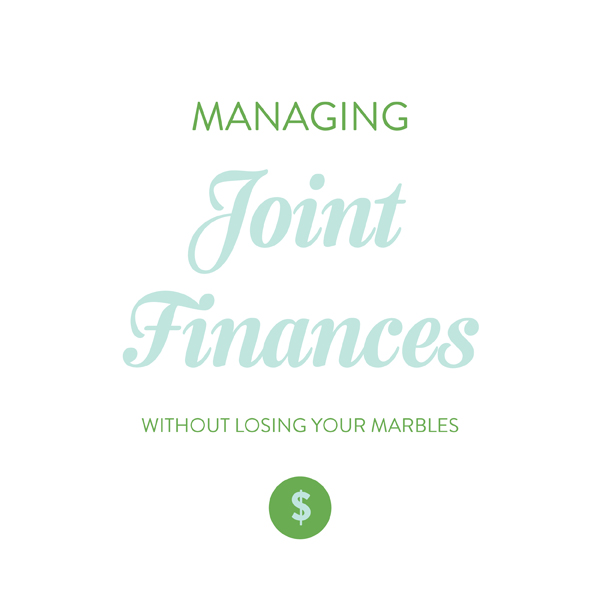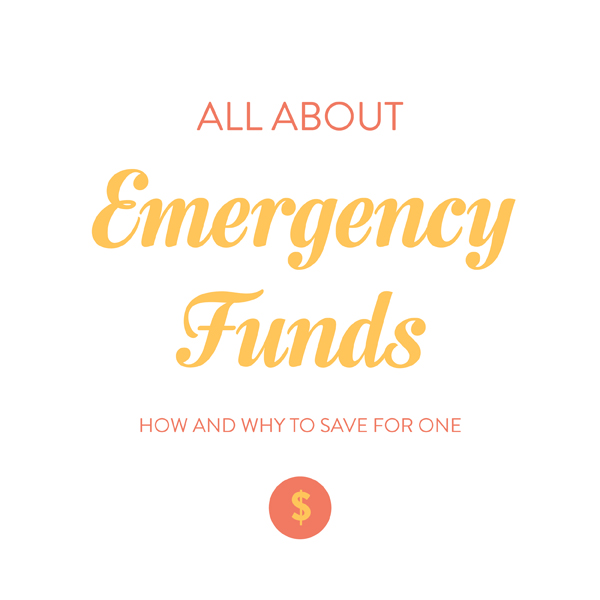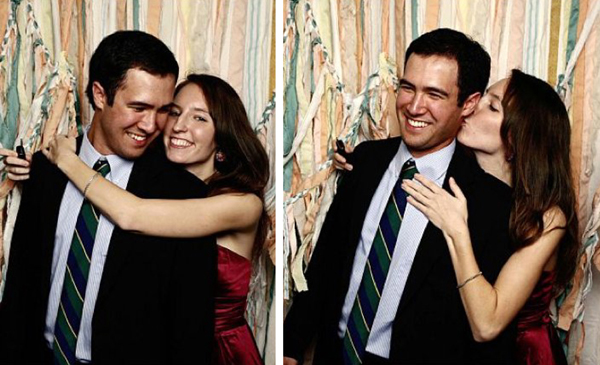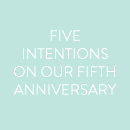24 January 2013
Hi friends! Hooray for Thursdays! And hooray for another Marvelous Money post! I was tempted to launch right into budgeting this week, because it’s so important and so many of you are interested in the subject, but I thought it might be better to talk a little bit about managing joint finances first.

Let’s start with a little timeline of our joint financial history, shall we? Consider it a case study.
Senior year of high school: We begin dating. Our finances are completely separate.
Sometime during college: We both independently open savings and checking accounts at the same bank, ING Direct. We keep our own budgets and have our own savings goals, but talk often and openly about what’s going on with our money. (What can I say, we love personal finance!) When we do something together like go out for dinner, we either take turns paying, or reimburse each other after the fact. (ING has a nifty electronic transfer feature which makes this very easy.) We have the same campus job and earn roughly the same amount, so this system works well for us.
Summer 2009: We graduate – whoo! We move to NC and became a one-income “family.” We consider ourselves a financial unit, even though we are not married. (However, all of our accounts are still separate.)
2010: We begin keeping one joint budget instead of two separate budgets. We both contribute to mutual savings goals like our emergency fund, wedding, and vacation. John becomes the point person for our investment and retirement accounts while I manage the day-to-day duties of making sure every bill gets paid. We agree that neither of us will rack up a large joint expense — or really any unexpected joint expense — without consulting the other.
2011: We co-sign on each others’ cars.
2012: We give each other access to accounts, but maintain individual IRAs, discretionary investment accounts, checking and savings accounts, and credit cards. John begins helping to pay down my student loans. We get married :)
SO that’s us in a nutshell. But, what does this look like on a day to day basis? Currently, we pay our joint bills out of my checking account, and then I bill John for his share. (I just total everything up and email him the amount once a month, and then he transfers it electronically back to me.) Our joint expenses get paid on our joint credit card, which also gets paid twice monthly out of my checking account. We pay expenses proportionately — so, if one of us makes 40% of our joint income, then he or she pays 40% of the joint expenses. Since John pays for some joint expenses I do not, like our health insurance, I compensate for that by contributing a larger amount toward our joint savings goals and debt reduction plan. Any money left over stays in our individual accounts for paying individual expenses or individual savings.
I tell you all that to show you how one couple manages their joint finances, and I hope it was helpful! Our system works for us; it may or may not work for you. Whether you feel good or bad about the current state of your joint finances, I have a few suggested action steps for you this week:
1. START TALKING. If you’ve never done so, or haven’t done so in a while, sit down with your partner and talk about what accounts you have, how much is in them, how much debt you have, how you expect money to be handled, your beliefs about giving, and your hopes for the future. Talk, talk, talk! And, of course, do lots of listening. Many sources say that money problems are the number one cause of relationship problems, so this couldn’t be more important. Get comfortable talking about money!
2. EVALUATE. Pick a time to sit down together and talk about the system you’re currently operating under. Is it working? Could it be improved? Are either of you doing something that stresses out the other?
3. PUT IT ON THE CALENDAR. If you’re not in the habit of talking regularly about money, I’d highly recommend putting a monthly money meeting on your calendars. Saturday mornings work well for us. Plan to talk about what’s working and what’s not, about what’s coming up that month, about progress made toward long term goals, about the state of the budget. I know that might sound a little basic, but it’s amazing what can happen when you’re in step with your partner and focused on the same goal – your whole perspective changes on what’s possible!
Speaking of which… next week: The nitty gritty of how, exactly, we make and stick to a written budget. In the meantime, I would really love to hear what y’all think. Do you use one joint account, all separate accounts, or a combination? We are certainly not perfect, and tips are always welcome!!
P.S. New to this series? Check out this post, where I tell our money story and explain why I think financial literacy is marvelous.
17 January 2013
Hello, friends! Thank you SO much for your feedback on my first Marvelous Money post! I’ve noted all of your questions and thoughts and look forward to discussing them together over the next few weeks. For our first nuts and bolts post, I wanted to begin with a topic many of you brought up: the emergency fund.
Let me be clear: I am NOT an expert on personal finance, and so there are very few things that I will ever say with absolute certainty on the subject. Here’s one: If you don’t have an emergency fund, you need one. Several of you commented that you fell back on credit card debt when unexpected expenses came up. We can’t change the past, but we CAN change the future, so let’s just agree that from this point forward, that is not going to be an option for any of us, ever. Okay?
Wonderful! Now let’s talk emergency fund.

An emergency fund is for:
— paying for something you had no way of knowing was coming and that would have a major impact on your family if you don’t cover it. Examples include paying the deductible on insurance (health/homeowner’s/car), medical bills from an accident or unforeseen medical problem, or a major problem with a necessary car.
An emergency fund is not for:
— buying a piece of clothing that’s on sale, a couch (or even a washer/dryer), a car, or a vacation.
— building wealth (more about this below).
What does an emergency fund look like? Almost every source suggests a fully funded emergency fund should cover three to six months of expenses. If you have a steady, secure job (think honestly about this) that you’ve held for a while and everyone in your family is healthy, then three months might be sufficient. If you are self-employed, work in a sales or commission-based job, and/or have chronic health issues, I’d lean toward the six month mark. For young people in this economy, I’d lean toward the six month mark.
Your emergency fund should cover expenses, not income. If, say, you lost your job, you’d obviously try to cut back in as many areas as possible, but you’d still have to have somewhere to live, have something to eat, and continue to make any recurring payments like a car or student loan. For most families, an emergency fund ranges from between $10,000 to $30,000. Right now, John and I consider our emergency fund fully funded with about five months of bare bones expenses.
How did we do it?
— We established an emergency fund savings account in January 2010, and each contributed an initial lump sum (I believe about $2,000 each, from our high school and college savings). If having that type of money to use seems so far from your reality, it’s okay! It will just take you a little longer to get to the fully funded mark.
— Next, we started saving. In 2010, we each contributed $75 a month into the fund. In 2011, we actually decreased our monthly contribution to $50 each and put the difference (and then some) into our wedding savings account.
— In December 2011 I received a very generous Christmas gift from my grandmother that allowed us to complete our fund. We were very fortunate to receive this gift, and gratefully recognize it made the process easier for us. However, if you’re tempted to shrug off our efforts, I’d humbly remind you that we made the decision to put that money into our emergency fund instead of, say, going on a vacation, or buying a new couch. (And trust me, when we first graduated from college and our entire living room of furniture consisted of ONE three-year-old loveseat from Ikea, we really wanted a new couch.) There were other virtuous things we could have done with the money, like pay down our debt, but given the experience we had gone through with John’s unemployment, we wanted to make sure we were secure should we ever face that situation again.
In order to make the process as painless as possible, we set up an automatic monthly transfer from the checking account where our paychecks are deposited into our emergency fund savings account. If you’re able to set up a transfer directly from your paycheck, even better! I think you’ll be surprised to find that you don’t much miss it if it’s not there to spend. Even if it’s only $50, transfer it from EVERY paycheck, and resolve not to touch it. Just pretend it’s not there!
Over time, increase the amount that you’re saving. It might take years, but eventually you’ll have a very comfy cushion to fall back on, should you ever need it. And really, it’s okay if it takes years! Just the mere existence of a cushion allows you to focus on other things (and keep building a bigger cushion), because you’re not constantly being sent back to square one/back into debt the minute something unexpected happens.
Saving for an emergency fund is NOT fun — or at least, it wasn’t for me, and I am someone who really loves saving :) A good emergency fund is B-O-R-I-N-G. It has to be an account with easy access and basically zero risk, which typically means a standard savings account. With our current low interest rates (0.75% on mine right now), your returns are going to be tiny even on a large chunk of money.
Worse, there’s no anticipation of saving up for something fun, like a vacation or a wedding. At the end, you won’t have anything to show for your work, like a house, since most of us don’t go around flashing our bank statements. The motivator here is lifelong financial security, which, while AMAZING when you step back and think about, is not as gratifying in the short term.
BUT, the AWESOME thing about an emergency fund, is that once you fund it, you can check it off and move on, unlike, say, retirement savings. Even if you are forced to dip into your fund, it’s unlikely you’d need to wipe it out in one go. And if, at the end of your life, you still have a fully funded emergency fund? Well, you’ll just have more to give away — not such a bad problem to have :)
Here are my three best reasons why YOU (yes, you!) should get started with an emergency fund today:
1) It takes no time. You just need a savings account and an automatic transfer, and you can set it and forget it. There’s no need to monitor the account closely.
2) It takes no experience. Again, the investment tool is very simple and stable, so there’s almost no way to do it “wrong” — unless you don’t do it at all.
3) It takes not very much money. Unlike, say, paying off debt, it’s okay if you go slower on this one. I would suggest making an initial contribution of $250 or $500, or $1000 if you can swing it, but from there, start with whatever monthly contribution is comfortable for your budget and try to increase the amount every year.
YOU can do this friends! And you will feel so good when you do, I promise!!
So tell me: Have I convinced you? Do you already have a separate emergency fund, fully funded or not? If fully funded, how long did it take you to get there? If not, are you going to start one today? :) Any questions I didn’t answer?
As a reminder, my advice is meant for someone in a generally stable financial position. If you are facing serious financial problems or significant debt, I would suggest seeking professional help, as there are likely other steps you should prioritize.
11 January 2013
Hello, friends! Happy Tuesday! A long time ago, I asked if you all would be interested in an occasional money series on Em for Marvelous. Turns out you were interested (as was I), but nothing ever happened. And that’s pretty sad to me, because I LOVE talking about all aspects of money management, and financial literacy, especially amongst young people, is a huge passion of mine and John’s.
So, better late than never, right? I thought we’d try a once-a-week series for the length of January (since so many people put financial goals on their New Year’s lists!), then slim down to maybe a once a month post until I run out of things to say or y’all get bored. I have lots of ideas for future posts, but please let me know in the comments if there’s something in particular you’d like me to cover!
To begin, I thought I’d tell you a little bit about our money story, so you can see where I’m coming from and decide for yourself whether or not you’d like to take my advice :) I think there’s a lot of power in taking a hard look at your money past, and really thinking about your ideal money future, so I’d encourage you to do the same after you read this! Here goes!
I can remember writing out an allowance savings plan for Breyer horses when I was in fourth grade. I started saving for my wedding my freshman year of college. (Don’t worry, I didn’t tell anyone.) I opened an IRA the following year. Though I was and always have been a saver and a planner, I didn’t become passionate about personal finance until John did.

Lover of ponies and planning from a young age (I’m on the right)
Like me, he was definitely hardwired with more than your usual dose of responsibility at a young age, but was not overly concerned about money management. We both started our college careers with a decent amount of savings in the bank (for seventeen-year-olds), but by the time spring semester rolled around, John was scraping the bottom of the barrel. This is mostly my fault (though indirectly), as most of it disappeared through monthly fresh flower deliveries (we attended schools ten hours apart at the time), plane tickets for visits, and food and entertainment during said visits. The rest can best be explained by living in a city for the first time — the general expense of dining out, etc. — and the lack of a job to replace the outflow.

Visiting John in DC spring 2006!
So when the last few weeks of the semester rolled around, his accounts had pretty much run dry, to the point where he needed a cash infusion from his parents to continue eating for the last few weeks. Even though this might not seem like much of a reckoning, it left scars that now run quite deep in John’s psyche. Because he loves his parents, respects them so much, and is so grateful for everything they’ve done for him, he HATED imposing on them in that way, especially when they were already generously funding his schooling. This experience, combined with his world-altering discovery of and subsequent love for economics freshman year, put him on a firm path toward personal financial excellence, and gave him a huge passion for helping others to become financially fit, as well. I was (and still am!) happy to be along for the ride!
We both held part-time jobs for the rest of college, followed individual written budgets, and finished in good financial shape, with savings in the bank and (small) IRAs and investment accounts in our names. I had a few student loans, but thankfully they were not as serious as many of my peers’. The wedding savings account was coming along nicely :)

Then, I decided to take a job in North Carolina with a very uncertain salary situation. We moved basically sight unseen the summer after we graduated. Thankfully, my salary became regular and decent fairly quickly, but for a year and a half, we were a one-income household while John searched for a job. Even though we lived frugally, this ate away at much of both of our savings.

Once John started working (in October 2010, in the financial sector), our financial burden lessened substantially, and we were able to really concentrate for the first time on our financial goals. We initially focused on saving for our wedding, and ultimately contributed 20% of the total cost (September 2012). At the same time, we squirreled money away in our emergency fund until we finished funding it in January 2012. All the while, we paid down our three student loans and two car loans, paying off the first of the five in December 2012. At the same time, we’ve been vigorously putting money away into our down payment fund, and are now at our minimum goal. Throughout, we’ve stayed on track with a written budget, and stayed focused by working toward tithing and giving to other organizations and causes close to our heart.
Whew! That’s a lot to let loose in one post (and you know I was chomping at the bit throughout to add explanations and even more detail!!). I’ll be back next week with some more thoughts on our overall money philosophy, but in the meantime, I’d love to know: would you consider yourself, at heart, a spender or a saver? And, is there anything in particular you’d like me to cover in future posts? Budgeting? Retirement savings? Debt? Investing in general? Let me know!
























